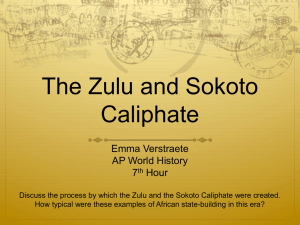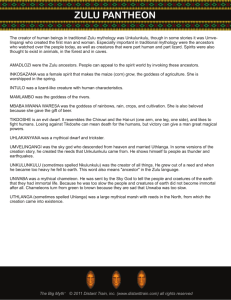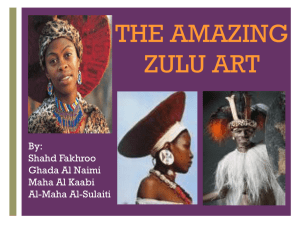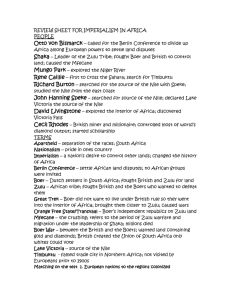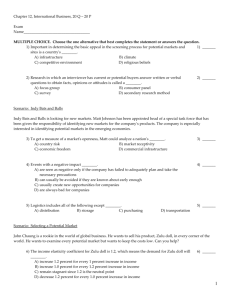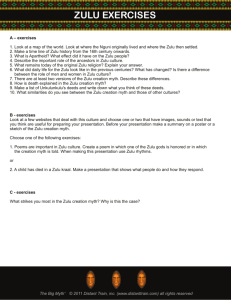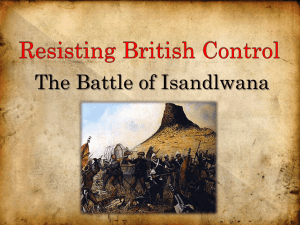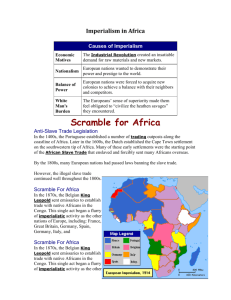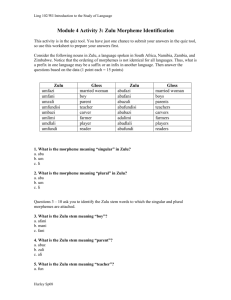Reevaluating Zulu Religion: An Afrocentric Analysis
advertisement
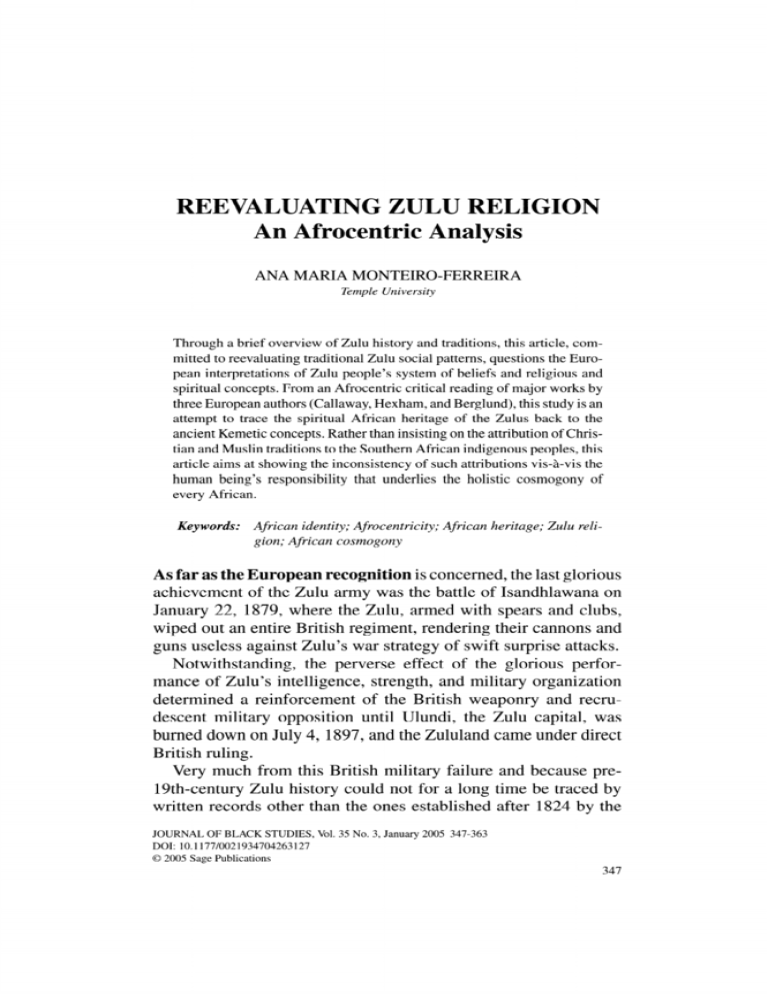
REEVALUATINGZULU RELIGION An Afrocentric Analysis ANA MARIA MONTEIRO-FERREIRA TempleUniversity Througha brief overview of Zulu historyand traditions,this article,committedto reevaluatingtraditionalZulu social patterns,questionsthe European interpretationsof Zulu people's system of beliefs and religious and spiritualconcepts.Froman Afrocentriccriticalreadingof majorworksby threeEuropeanauthors(Callaway,Hexham,andBerglund),this studyis an attemptto trace the spiritualAfrican heritage of the Zulus back to the ancientKemeticconcepts.Ratherthaninsistingon the attributionof ChristianandMuslintraditionsto the SouthernAfricanindigenouspeoples, this articleaims at showing the inconsistencyof such attributionsvis-a-vis the human being's responsibility that underlies the holistic cosmogony of every African. Keywords: Africanidentity;Afrocentricity;Africanheritage;Zulu religion; Africancosmogony As far as the European recognition is concerned,the last glorious achievementof the Zulu army was the battle of Isandhlawanaon January22, 1879, where the Zulu, armedwith spears and clubs, wiped out an entireBritishregiment,renderingtheir cannonsand guns useless againstZulu's war strategyof swift surpriseattacks. Notwithstanding,the perverse effect of the glorious performance of Zulu's intelligence, strength,and militaryorganization determineda reinforcementof the British weaponry and recrudescent military opposition until Ulundi, the Zulu capital, was burneddown on July 4, 1897, and the Zululandcame underdirect Britishruling. Very much from this British militaryfailure and because pre19th-centuryZulu history could not for a long time be tracedby writtenrecordsother than the ones establishedafter 1824 by the JOURNALOF BLACKSTUDIES, Vol. 35 No. 3, January2005 347-363 DOI: 10.1177/0021934704263127 © 2005 Sage Publications 347 348 JOURNALOF BLACK STUDIES/ JANUARY 2005 reportsof the Europeansettlers in Natal, the Zulu peoples have gainedtheirreputationas ruthlesswarriors,as well as a people with no religion. On the Zulu side, however,the need for survivalto the preconceived ideas of the Europeanmissionariesand tradersand to the colonialismof the Europeanpowersmadethemtenaciouslydefend theirculturalheritage,andtheirformerprideandpoliticalposition in South Africa have been regained in the 20th century under Buthelezi. Nowadays,the largestZulu populationcan still be found in the regionof KwaZuluon the easterncoast of Africa,butmanylive in the cities of urbanSouth Africa where, accordingto an estimate, approximately8 million South Africans considered themselves Zulu or membersof closely relatedethnic groupsin the 1990s. As historicalsources put it, the Africanpeoples who settled in subequatorialEasternandSouthernAfricadescendfromtwo broad groups: • theKhoi-San, hunters andcattleraisers,ochre-skinned racesdescendentof EarlyStoneAge progenitors, who livedall overSouthern Africa;and • theBantu,a termderivedfromtheZulucollectivenounfor "people"of Blackraceswho lived in the GreatLakesregionof subAfrica.Bigger,stronger,moreaggresequatorialCentral-to-East and more sive, advanced,theydisplacedthoseof technologically Khoi-Sanoriginwhena growingpopulation requiredmoreland. The Bantu-speakingpeople weredividedinto two broadgroups: Nguni-speakingpeople who are the Zulu ancestors,and speakers of otherAfricanlanguages. The Nguni people arenamedafterthe charismaticfigurewho is said to have led a migrationfrom Egypt to the GreatLakesvia the Red Sea corridorand Ethiopiaand settled in the mystical Embo. At that time, there was not even a clan called Zulu among those who made up the Nguni people but their wealth was measuredin cattle, a traditionthat continued throughoutthe modern Zulu Kingdom.1 Monteiro-Ferreira / REEVALUATINGZULU RELIGION 349 Most of the speakersof otherlanguages,such as Sotho, Tswana, Tsonga, and Venda,lived in the interiorof the country. Some 3,000 yearsago, when the explosion in populationof both people and livestock led inevitablyto the quest for new land, the Nguni chiefs began moving their communities.First, they moved east andsoutheastinto the territorymakingup modern-dayZambia andZimbabweandlater,duringthe 16thcentury,into the beautiful coastal stripof Maputaland,modernMozambique. Under this extremepressure,the Lala people, descendedfrom the Khoi-San,were forced to eitherintegrateor move on. These are historical divisions of what is nowadays generally known as the Zulu peoples, whose backgroundof historicalconquests has made them a multiculturalsociety bound togetherby similarlanguages,similarritualsandcelebrationsperformedaround common symbols, and common Africansystems of beliefs. The social organizationof the Nguni clan includedan extended polygynousfamily determinedby male lineage as well as otherrelativesthrougha varietyof kinshipties andpeople who hadattached themselves to the householdor imizi. These social units were politically organized into chiefdoms ruledby the dominantlineage of the strongestclan. Chiefdom typically includeda groupof relatedpatrilinealclans or descent groupsunitedby common ancestryonly a few generations deep. These paramountchiefs, however, had insufficient military strength to guaranteeloyalty among the vassal chiefs, and their influence thus expanded or disappearedas the result of shifting allegiances or the birthof new clans as chiefs' sons went forth to establishnew homesteads. This was exactlywhathappenedto the rulingdaysof Malandela, when such a clan came into being by virtueof his son, Zulu, a high spiritedand determinedyoung man whose name means Heaven. Zulu,his wives, andhis followersaccompaniedthe new clanfurthersouthto the MkhumbaneRiverbasin wherehe establishedhis own small realm- the first KwaZulu,or Place of Heaven or Sky. 350 JOURNALOF BLACK STUDIES/ JANUARY 2005 FIGURE 1 The Zulu Village Zulu built his homesteadaccordingto the Nguni tradition.The cattle-fold'scentralpositionwithinthe kraal2evincedanimals'crucial role in society. Cattle were centralto most Nguni economies, with an almost complete dependenceon herdingand crop cultivation,often supplementedby hunting.Cattlewere also used for the lobola (dowry) thataddedmorewealthto the clan when the girls were marriedoff; cattle were also the sourceof meat and milk, with theirhides used for clothingandbattle-shields.Cattle,andespeciallythe cattle-fold where ritualsand ceremoniesin venerationof the ancestorstook place, were of ritualsignificancetoo. The clan's homesteadswere arrangedin a crescentat the higher end of a sloping piece of land with irregularlyshaped fields for planting grains and vegetables aroundit, which made them selfsufficiententities (see Figure 1). Until the 18th centuryor later,historiansbelieve, these chiefdoms were not unitedundera king or monarch. In 1805, Dingiswayo, the leader of the Mthethwapeople, had become increasinglyimportantdue to his militaryconquests and dominatedmuch of the region northof the Tugela River. / REEVALUATINGZULU RELIGION 35 1 Monteiro-Ferreira After the paramountChief Jobe's death,he claimedthathe was Ngodongwana,one of Jobe's sons, and took over political power. To consolidate his political position, Dingiswayo called the other chiefdoms into a confederacy and introduced important reforms,both social and political. Not only did he createa regular army but he also abolished circumcisionas the ritual of passage into manhood.Instead,he replacedit with the ritualof enteringthe army.He establisheddifferentarmyunits based on age-set, distinguishableby dressings and shields to create a sense of pride and identity.This was the first permanentarmedforce in the region. Shaka,who was a child of Senzangakona,Zulu chief in 1787, joined Dingiswayo's armyat the age of 16 and won recognitionin 1810 by skillfully subduing the leader of the warringButhelezi chiefdom. Apparentlyloyal to Dingiswayo while he lived, Shaka took advantageof Dingiswayo's militarydefeat by the neighboring Ndwandwe armies and began building the Zulu empire after Dingiswayo'sdeathin 18 18, establishingits capitalin Bulawayo. Unitedby Shaka,the Zuluor Amazulukingdomgainedsupremacy over almost two thirdsof South Africa duringa period of 10 years. Shaka Zulu (r. 1817-1828) became a remarkableking by adoptingnew fighting strategies,by consolidatingcontrolover his militaryregiments,andby the enduringwarfarecapabilitiesof his warriorregiments,the impls. In 1879, the Zulus inflicted that major defeat to the British armiesat Isandhlwana,but this triumphparadoxicallydictatedthe destructionof the Zulu nationas an independentkingdom. TheZuluempireweakenedafterShaka'sdeathin 1828 andfragmented, especially following militarydefeats at the hands of the Afrikanersand the British. Zululand,the areanorthof the TugelaRiver,was invadedby the British armies and finally incorporatedinto the British colony, Natal, in 1887. Among the many consequencesof the destructionof the Zululandas an independentnation,thereis one thatneeds specialreference: the increasingactivity of the missionariesamong the Zulu peoples and theirconsequentconversionto Christianity. 352 JOURNALOF BLACK STUDIES/ JANUARY 2005 Althoughthe presenceof EuropeansandArabsamongthe African peoples in general was known, prior to 1824 very little was reportedabout the Europeansliving among South African clans, and even less was known abouttheircontactwith the Arabs. Next to 1824, however,therearereportsof mutualarrangements between Europeans,mainly adventurersand traderswho established in PortNatal (now Durban)for a base for tradewith the interior populations,and King Shaka, very much interestedin their guns and powder. Muchof whathas been writtenaboutthe Zulupeopleshas thereforebeen authoredby theseEuropeantradersandmissionariesduring the first 50 years of contact,andtheiraccountsreflect the contradictionsand misunderstandingscreated by the clash of two differentstages of developmentand worldviews. Althoughwe may not totally agreewith Mazrui's(1986) theory of a mixed legacy or "Africa'sTripartiteHeritage" (Asante & Abarry,1996, p. 21 1) as the culturalcoalescenceof Africanindigenous cultureswith Christiansand Muslims from the 1st and 7th centuriesA.D. onward,and especially afterthe colonizing experience of the 15thcentury,we must undoubtedlyconsiderthatthere is an extremelyimbricatepatternof culturalfusions that must be sorted out to reach the African essence of Africa and deploy the generally accepted interpretationsof African cultures from nonAfricaninfluences. Following modern African historians like Diop (1974),3 Obenga,andAsante,who partakein the idea that"betweenthe earliest writingsin the Nile Valleyandthe variedwritingsof Africans at this moment of history, there are fascinatingand illuminating culturallinkages"(Asante& Abarry,1996, p. 11), I intendto demonstratethatonly by divinginto classicalAfricacan we understand what is truly African about Africa. Otherwise,the preconceived ideas of the Europeansabout African peoples and the extent to which they have changed,influenced,and sometimeserasedAfrican culturewill hardlybe fully assessed. Only throughthe questioning of present-dayoverviews of Africanhistory and religion, servedby WesternEuropeaninterpretationsthat make the task of understandingwhat are the traditionalroots of African religious Monteiro-Ferreira / REEVALUATINGZULU RELIGION 353 ideas a very hazardous one, will we find the path to the true African heritage in ancient Kemetic civilization. This is, in its essence, the Afrocentric perspective that allows for the understanding that although each African society has developed its unique orientation in the quest for a functional and holistic understanding of the universe and the mysteries of life like birth and death, a common spiritual heritage can be traced back to the ancient Kemetic concepts of the origin of the world and the human beings based on three common functional principles that can be identified in all African religions and whose source is the religious and philosophical thought of Kemet: Harmony,a concept thatkeeps a close religious relationshipbetween humans,and between humansand the environment; Ethics or Ma 'at thatin African societies is the generativeprincipleof right and righteousness, balance, justice, harmony,respect, and dignity;and Ancestorsworshipthatembodiesthe conceptof epic memoryandwisdom, which is the source of ethical teachingsand social harmony. SOURCES For the purpose of this study that I claim to be an Afrocentric critical reading of Zulu peoples' system of beliefs through the many interpretative problems that still can arise in the recognition of true African concepts, I selected three major works on Zulu history and religion: • The outstanding selection of the most representativetexts by Nathaniel Isaacs (1836), Allen Gardiner(1836), Francis Owen (1837), and William Holden (1866), among otherauthors,cited in Hexham(1987); • The re-editionof the extremelyvaluablepublicationof The FolkLore Society, London, in 1884 of a three-partbook by Reverend HenryCallaway(1884/1967); • The remarkablestudyof contemporary"traditionalreligion"of the Zulu by Axel-IvarBerglund(1976). 354 JOURNALOF BLACK STUDIES/ JANUARY 2005 DISCUSSION AlthoughHexham'sselectionof texts leaves us with the authors' interpretationsof what they could see and experienceamong the Zulu during the 19th century, and Berglund's book very much relies on his interpretationsof the extensiveethnographicresearch done among 20th-century informants, reading Callaway's outstandingworkofferedme whatI considerto be a muchmoregenuine insight of the Zulu people's system of beliefs. He named his manuscript- based on the Zulu people's oral traditions- IzinyangaZokubula;or Divinationas ExistingAmong theAmazulu,in TheirOwnWords,Witha TranslationIntoEnglish, and Notes. The majorityof his notes, however,are language explanations and the translator'sclarificationsof more obscurestatements. The thoroughrecordingof the storiestold by the wisdomof ageold Zulu individuals,the carefulquestioningto allow the deepest understandingof detail, and the considerationof differentclans' sourcesguided my attentioninto what I considerthe most importantchallengefor researchersof Africanreligionsnowadays:Is the belief in a Supreme Being compliant with the concept of an AlmightyGod amongthe manyAfricanethnicgroups?Is it a result of eitherMuslim or Christianinfluences, or is it partof a coherent Africanreligious thoughtpattern? The texts compiled by Hexham are authoredby churchmen, mainly traders and missionaries. Although some of them, like Callaway,might have had a thoroughawarenessthat "someof the statementshere made are the results of contact, in some way or other,withEuropeanteaching"(Hexham,1987, p. 466), they could not escape eithertheirpersonalbias of the inheritedaccessoriesof theirown religion and Europeanworldviewor the Christian"contamination"of their sources. Berglund(1976) was also awarethat "aninteractionhas taken place between traditionalZulu beliefs and those of missionaries andotheroutsiders"(p. 26) andthatstatementworkswrittenin the 1930s presented similar problems of understandingZulu traditional religious beliefs withoutinceptionsfrom Christianity.Not- Monteiro-Ferreira / REEVALUATINGZULU RELIGION 355 withstanding,he could not make a clear distinctionbetween past andpresentbeliefs, andby readinghis studywe get the idea thata Zulu Sky God or Lord-of-the-Skyis the same conceptualidea that Eiselen and Schaper(1937, cited in Berglund, 1976) designateas Lord of Heaven, and Bishop Sundkler(1948, cited in Berglund, 1976) names High-God. My contention,however,is thatno suchconceptof one Supreme God governingAfricancosmogonyis even consistentwiththe spiritualvalues andethicalresponsibilitiesof the humanbeing in Africans' holistic sense of oneness of humankindand nature. Actually,I preferto tracethe meaningof this sense of onenessof humankindwith nature back to the Kemetic concept of Ma'at, understoodas the balancedand harmoniousorderof the creation where spiritand matterare inseparable. It was humanbeings' dutyto activelymaintainthis harmony.To pursuethis crux ethical principle,the quest for truth,justice, harmony, and balance ought to be inherentto the righteousperson, whose spiritualrighteousnessandtightnesswas morethana "transpersonalexperiencewithinthe humanorder.... It is a continuous process by which [Africans]align [themselves]with the harmony [they] find in nature"(Asante, 1998, pp. 83-84). It is of no wonder,then, that the Zulu- being a Nguni people said to have descendedfrom Egypt to the GreatLakes via the Red Sea corridorand Ethiopia- focus primarilyon the principlethey call Ubuntu:They exist becauseotherpeople exist. This is a powerful concept that they define as the belief that humansare humans only becausethey interactwith otherpeople andnature,andif they wereto ignorethe restof humanityandtryto live in a vacuum,they would be less thanhuman. This is also the core of the ZuluPersonalDeclarationthatbegins (Asante & Abarry,1996), "I;I am; I am alive; I am conscious and aware;I am unique;I am who I say I am; I am the value UQOBO [essence]" (pp. 371-378). The Zulu personaldeclarationis, so to speak, the corpus of the philosophical and ethical values of the Nguni populationswhere all the correlationbetween Kemeticand Zulu philosophicaland religious systems can be found. 356 JOURNALOF BLACK STUDIES/ JANUARY 2005 It is the relationshipof humankindwith natureand the natural phenomenathatare the centralissues in the Africancosmological understandingof life, death, and creation.Like the ancientEgyptians, Africansbelieved thatthe fundamentalprincipleof creation was the equilibriumof opposites, a perfectly establishedenergy whose force regulatesthe universe;andthe harmonythatpreexists to chaos is translatedinto Ma'at "as the organizingprinciple of human society, the creative spirit of phenomena,and the eternal orderof the universe"(Asante, 1998, p. 89). These cosmological and ethical concepts were recreated throughoraltradition,narrativesof creationgenerationaftergeneration, symbolizedby the spiritof the ancestors,the guardianof an individual'squest for the generativeforce of cosmic harmony. Fromthe narrativesof creationof differentZulu ethnic sources, one consistent concept of a First Creator- Ukulunkulu,Unkulu- emerges.And this is whatthe essence of nkulu,or O(n)kulukulu ReverendHenryCallaway'swork is about. The whole set of narrativestranslatedby Callawayunanimously points to Unkulunkuluas an agelessness concept of a first human being who came to be beforetime, as we conceive it, andis said to have made all things and given them to humankindto dispose of them. Then he died. He did not leave any laws or regulationsto be followed, the living presentbeing but the renewedfollow-up of past experiences, the actualizationof a previousmatrixinscribedon an immemorial time whose teachingsis the ancestors'duty to perform. Because the Zulu people believed in a humanfirst creatorwho died away,Unkulunkulu,unlikea SupremeGod, has less influence on theirlives (Berglund,1976, was also quiteawareof this) thanthe spirit of the ancestors whom they can place in a time they can recognize. When we take the Zulu oral traditionsof creation,the notion of Unkulunkuluitself is a personal concept, creating and backing away,lost in a non-timedimension,which seems muchcloserto the Kemeticconceptof a FirstOccasion(TepZepi)thatcontainsall the blueprintsof a commonlife thanto the SupremeGod of the Chris- Monteiro-Ferreira / REEVALUATINGZULU RELIGION 357 tian and Muslim traditionsthatgovernshumankindand the entire universe.4 On the other hand, the ancient Kemetic people also dealt with this nontemporal/nonspatial concept of movementfrom nonexistence into existence. Ratherthan conceiving of an all-governing God, the Zulu peoples, following ancestralAfricanreligious systems, believe in the existence of ever-presentancestralspiritswho watch over daily activities, promote social harmony,and create a sense of accountabilityamong its members. Unlike the wordshades coined by Berglund(1976), which is, in my opinion, both a negative and a static notion reportingto the underneathworld of the dead, the concept of spiritsapplies to all things. African ontological systems revolve aroundthe core concept of the spiritsas the vital universalenergythatembodiesall living things, humanbeings and naturealike. Africans'holistic concept of humankindand the universe,whose balance and harmony has to be respected,turnedthe respectfor the spiritsinto a sacred notion thatrequiresa sense of agency. The conceptof an AlmightyGod rulingoverhumankindandthe universeas well as the polarizednotions of good and evil and the sense of guilt centeredon the individualarethereJudaic-Christian fore incompatiblewith the Africannotion of collective agency and reciprocalrespect.Inversely,amongAfricanpeoples, good andbad coexist and are partof everythingand of everydaylife. It is every humanbeing's responsibilityto preventchaos andactivelyseek for balanceandharmonyin the community.Insteadof guilt, shameis taboo amongAfricans.It is shamefulto be cast out from the community when wrong actions create chaos and the disturbanceof ontological order. Therefore,it is all membersof the homestead'srequirementto be at peace with one anotherandnature.Forinstance,before social events or medicinaltreatmentcan take place, peace and harmony among lineage membershave to be achieved, and this provides a significantincentiveto resolve theirdifferencesexpediently. Because thereis no writtenbook of preceptsto guide theirmoral and ethical life, Zulu peoples, following traditionalAfrican systems of beliefs, dependon the spiritof the ancestorsto teach them 358 JOURNALOF BLACK STUDIES/ JANUARY 2005 the principlesof harmony,of visible and invisible, the humanand nonhuman,the matterand the mind. Under this holistic and communalwisdom, whose archetypal imprintsdate back to the spirit of the ageless ancestor Unkulunkulu,oraltraditionsof the Zulupeoples developedtheirontological andcosmological systems, whose thoughtpatternsandexperiences are evinced by Zulu historiesof creation. The various reports by old Zulu people of different ethnic groups, as they appearedin Callaway (1884/1967), are unanimous about a centralconcept of antiquity,the old-old one or the great-great-greatgrandfather,the first ancestorwho no longer is, who died and no longer exists. This timeless conceptual framework in clans like the Amazulu, the Amabaka,the Unokgopoza, and the Uzimase embodies the generative notion of priorityUmvelinqangi(meaningthe firstout-comeror the firstto breakoff) and the potentialsource of being, Uthlanga, a feminine concept, and Unsondo,the moralconceptof perfectionandgoodnessas well as physical beauty. Unkulunkulu,both the ancientman andwoman,5is assignedby the Zulu peoples to a periodwhen ancientsunderstoodthe history of creationand told the new generationsthe accountsof Unkulunkuluand of the ancientsof long ago. This is the reasonthat the conceptualidea of a SupremeBeing whomthey mustworshipdoes not fit into the Zulupeople's system of beliefs. No one worshipsor praysto Unkulunkulubecausehe is so faraway.He is so separatedfromthemin theirmindsthatdirect connection between humankindand Unkulunkuluhas progressively been erasedandhe is not regardedas a commondeity.He is as naturalas rain,food, andcorn and men and women know of his existencethroughthese manifestationsthatarethe everydayliving proofof the existenceof a firstcreator.The idea of the Zulupeoples being indebtedto the first creatorhas to do merely with the good things he createdfor them to have a pleasantlife in harmonywith nature.Actually,he createdeverything;heaven, earth,and everythingthatexists didnot come into existenceuntilUnkulunkulupronouncedthem, namedthem, designatedthem, and taughthuman- Monteiro-Ferreira / REEVALUATINGZULU RELIGION 359 kind how to use them. This is again the central philosophical concept that can be tracedback to ancient Kemetic civilizationthe power of Nommo(cf. Asante, 1990; Karenga,1993). He left to the human beings the responsibility of the ethical behavior,of the good andbaddeeds, andthe ancestorsas bearersof balanceand harmonyin the community. Zulupeoples are,therefore,ancestors'venerators.They prayto, or else they venerateandrespect,theAmatongoor Itongo, which is the spirit of the ancestors,the spirit of the dead whom they call Amadholozi(pluralof Idhlozi) or Umoya,whom they believe will takecareof the living lineage, theirwealth,cattle,andthe harmony in the kraal.The Amatongo are, therefore,in charge of bringing correction,cure,balance,andharmonyinto the communityfor the good of everybodyandareas muchpresentin the homesteadjust as the living membersof the lineage. Communionwith the spiritof the ancestorsis perhapsthe hugest partof traditionalZulu culture performedin the ritualsacrifice of cattle. Wrongdeeds in the communityare "censored"by the spiritsof the ancestorsor Amadhlozi- those whose life is still remembered andwhose teachingsandexamplesareto be followed- andpropitiatoryrites are made in theirhonor. The dead of a lineage- Amadhlozi or Itongo, those who died and became the inhabitantsof the spirit world- manifest their spirit (Amatongo) by means of dreams, omens, or symbols that generallycome as advice, warnings,or protection.These areinterpretedby a divineror a doctorandrequirethe sacrificeof an animal (a bullockor a goat). Cattlekilling is thenthe most importantritual among the Zulu, and specific places within the kraalare, for that matter,the back wall of the chief's homestead where there is a shrine, called umsamo, to revere the Amatongo, the doorway throughwhich the spiritsof the ancestorsarewelcome, andthe cattle enclosure for the sacrifices in their honor, as we have already seen. Zulu'sfunctionalsystemof beliefs is completedby the symbolic position of Earth- a feminine concept of origin- and Sky- the masculine concept above. This symbolic position ties up human- 360 JOURNALOF BLACK STUDIES/ JANUARY 2005 kind andnatureas the balancingsubjectsof creationlike the crops and the rain. They say thatUnkulunkuluhad his origin in a bed of reeds and wateras well as everythingelse, and the knowledge of everything thatwas broughtforthby the powerof the wordof Unkulunkulu the powerof Nommo.Fromthe Sky above,personifiedby the spirit of the Lord-of-the-Sky,who emerged from the reeds like everything else, the Zulu got theirname (Zulu = sky). Accordingto the stories of creation,the sky is a big blue rock stretchedacrossthe surfaceof the earth,which is flat. The earthis conceived as being held up on the hornsof four greatbulls thatare the cause of the earthquakeswheneverthey shaketheirheads. The sky is differentfromthe earthonly in the sense thatit is believedto have perpetuallight. Otherwiseeverythingis similarto earth.The Lord-of-the-Sky,like the chief of the kraal,has his own cattlethat, by trampingon the muddygroundof the sky duringthe rainyseason, make the holes through which the sky light filters that are named the stars. Actually, the Zulu peoples did not interpretthe thunderandthe lightningas the wrathof God, neitherdid they conceive of such a divineentity.6Forthe Zulupeoples, the thunderand the lightningmeanthatthe king of the sky is playingwithhis wives. He is not angry.As for the lightningor hail, because they can kill people or cattle or destroythe crops, it is believed thatthey affect only those whose wrong deeds have harmedthe harmonyof the communityor the balanceof nature. These are omens whose meaning requires the extraordinary knowledge of the doctors,the most importantpersonin the social hierarchynext to the king or chief. As it is evinced by the diagram in the appendix, the Zulus' social organization,mirroredin the topographyof the kraal,reflectsbothZulus'cosmological andreligious interpretationsof the world.Butthey also mirroranimbricate patternwhere sorcerersand witches, following the popularexpansion of Christianconcepts of good and evil, the god and the devil, easily mingled with the naturalistictrendof the Africans'cosmological perspectives. Monteiro-Ferreira / REEVALUATINGZULU RELIGION 36 1 CONCLUSION Where do Christianinterpretationsclash with African worldviews? Where do they imbricate?How would one separateones from the others?It is an almostimpossibletask, I agree.However, from the various oral traditionscompiled by Callaway,although manycould not escape the Whiteman'sperspective,I drewthe following assumptionsas core issues in my effortto help correcta few misreadingsby non-Afrocentricscholars. The Lord-of-the-Skycannotbe regardedas the FirstBeing and the distantand unpredictablerulerwho is to be reveredandfeared (Berglund,1976), neithercan we assumeanyrelationshipbetween the Lord-of-the-Skyand Unkulunkulufor the reasons mentioned before;muchless can we regardhim as the nativedenominationto an Almighty God. Actually,it is not a matterof vocabulary.It is a matterof ontological views. Quitethe opposite,I would say thatthe importanceof the Lordof-the-Sky as well as the mythological figure of Unkulunkuluis inscribedin the functionalrelationshipbetween the humanbeings and the naturalforces thatregardthunderand lightning as partof life in the sky as much as on the earth. On the other hand, it is my opinion that the extremelogic and comprehensibilityof the Zulureligious andphilosophicalsystems became the fertile groundwhere the seeds of good and evil, sent overhumankindby an AlmightyGod of Christianinspiration,easily grewinto worshipandvenerationof a SupremeDeity,this Lordof-the-Sky as interpretedby Berglund. This is one more reason that I believe in an unquestionable urgencyto revisethe historyof Africanpeoples, reinterpretancient sources,andrereadandreevaluatepreviousconceptsforthe sakeof a trueAfricanconceptualidentity. This articlethatwas primarilycommittedto reevaluatingtraditional Zulu social patternsbased on theirtraditionalreligious system of beliefs underan Afrocentricperspective,avoidingthe focus of WesternEuropeanconceptualframeworkas much as possible, has anothermain purpose:to be challenging enough to stimulate 362 JOURNALOF BLACK STUDIES/ JANUARY 2005 new discussions and bring new light into African issues so that Africanreligionsmay be one moresourceof peace andunityrather than separationof Black people. APPENDIX Zulu Social Organization King / Chief / Headmanor Priest Diviners Doctors of Medicine or Healers HeavenDoctors Sorcerers Witches NOTES 1. For more information,please see http//Zululand.kzn.oig.za 2. A kraalis a village formedby the homesteadsof people with a commonancestor(lineage group). 3. Diop (1974) statedthat"thehistoryof Black Africa will remainsuspendedin air and cannot be writtencorrectlyuntil African historiansdare to connect it with the history of Egypt"(p. xiv). 4. See Asante (1990): "Akhenaton'sheresy, after thousandsof years of the Egyptian attemptfor harmonythroughMa'at workinginternally,was thathe sought in Aton the one cosmic generatorthatgave meaningto life. But this force, this one god heresy,was external, outside of the individual,a cosmic weaver weaving from afar.Thus, Akhenaton'sheresy was . . . [the attemptto replace] the individual'squest for Ma'at with a giver or chief of Ma'at"(p. 84). 5. Kulu = great, expresses age. This can be clearly understoodin the following word family: Ubaba- my father Umame- my mother - my grandfather• (or Ukulu) • Umame-mkulu- my grandmother Ubaba-mkulu Ukoko- ancestor(male, female) - ancientman or woman Unkulunkulu 6. CompareIsaacs (1836, cited in Hexham, 1987): "Chaka,when we firstheld a conversationwithhim on the subjectof the existenceof a SupremeBeing, at once evincedhe hadno idea of a deity, and thathis people were equally ignoranton this subject"(p. 38). Monteiro-Ferreira / REEVALUATINGZULU RELIGION 363 REFERENCES Asante, M. K. (1990). Kemet,Afrocentricityand knowledge.Trenton,NJ: Africa World Press. Asante, M. K. (1998). TheAfrocentricidea. Philadelphia:TempleUniversityPress. Asante,M. K., & Abarry,A. (1996). Africanintellectualheritage:A bookof sources.Philadelphia:TempleUniversityPress. Berglund,A-I. (1976). Zuluthought-patternsand symbolism.Bloomington:IndianaUniversity Press. Callaway,H. (1967). The religious system of the Amazulu.Nendeln/Liechtenstein:Kraus ReprintLtd. (Originalworkpublished 1884) Diop, C. A. (1974). TheAfricanorigin of civilization.Mythor reality.Chicago:Lawrence Hill Books. Hexham,I. (Ed.). (1987). Textson Zulu religion. TraditionalZulu ideas about God. New York:Edwin Mellen Press. Karenga,M. (1993). Introductionto Black studies. Los Angeles: Universityol Sankore Press. Mazrui,A. A. (1986). TheAfricans:A triple heritage.Boston: Little, Brown & Co. Ana Maria Monteiro-Ferreirais presently conducting researchfor her Ph.D. in American literatureand culture, gender and ethnicity at TempleUniversity.She receivedher M.A.in women'sstudiesat UniversidadeAberta,Lisbon,Portugal,and postgraduatein migration,subjectivity,and deconstructionat 1FU, Universityof Hanoverin Germany.She is a researcherat the Centrefor Anglo-AmericanStudies and the Centrefor the Studiesof Migrationand InterculturalRelationsof Universidade Aberta,Lisbon, as well as a boardmemberof the PortugueseAssociationfor Women's Studies.
